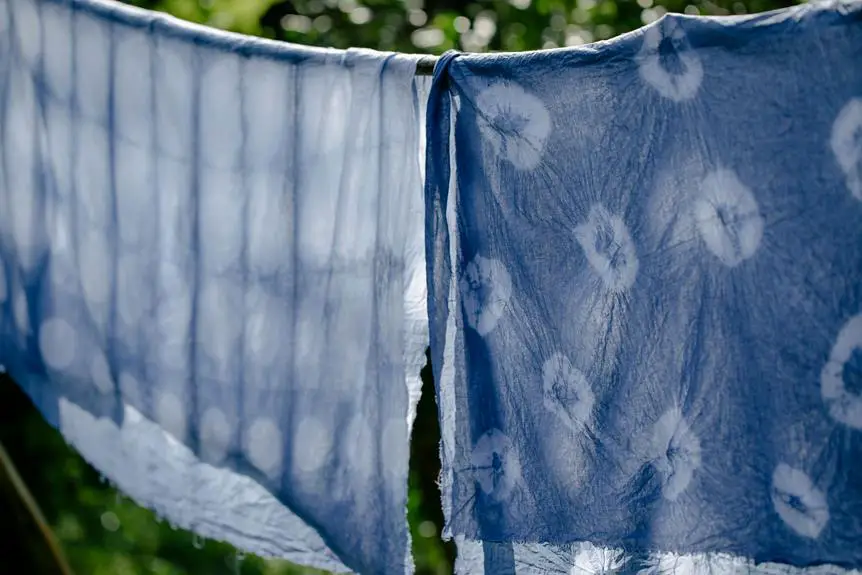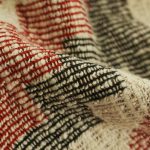As you consider your wardrobe options for the changing seasons, you may be wondering if poly tricot fabric is a suitable choice for year-round wear. This versatile fabric has gained popularity for its lightweight and breathable properties, making it a great option for warmer months. But can it also withstand the cold winter months? You might be surprised to learn that poly tricot's good insulation and moisture-wicking properties make it a strong contender for winter wear as well. But what about its performance in transitional seasons, and how does it hold up to varying weather conditions?
Table of Contents
Properties of Poly Tricot Fabric
When you're considering poly tricot for all-season wear, it's essential to understand the properties of this fabric, which is known for its unique blend of polyester and tricot weave.
You'll find that poly tricot is a lightweight, breathable fabric that drapes well and has a smooth, soft texture. Its polyester content gives it durability and resistance to wrinkles, while the tricot weave provides a subtle sheen and flexibility.
As you explore poly tricot further, you'll notice that it's also quick-drying and moisture-wicking, making it a great choice for active wear or clothing that requires ease of movement.
Additionally, poly tricot is often treated with finishes that enhance its performance, such as UV protection or stain resistance.
When it comes to care, poly tricot is generally easy to wash and dry, and can be machine washed and dried without losing its shape or texture.
Winter Wear Suitability
When considering poly tricot for winter wear, you'll want to examine its performance in cold weather.
You'll need to assess how well it insulates and breathes, as these factors will impact your comfort level in chilly conditions.
Additionally, you should evaluate its moisture-wicking ability, as this will affect how dry and warm you stay during outdoor activities.
Cold Weather Performance
Most people find poly tricot to be surprisingly warm in cold weather, thanks to its thick, plush pile that traps air and retains body heat relatively well. You might be wondering how it compares to other fabrics in terms of cold weather performance.
In general, poly tricot is a good insulator, making it suitable for winter wear. When you wear poly tricot clothing, you'll notice that it helps keep you warm even in chilly temperatures.
One of the reasons poly tricot performs well in cold weather is its ability to retain warmth even when wet. This is because the fabric's synthetic fibers don't absorb moisture like natural fibers do.
As a result, you'll stay warmer for longer, even if you get caught in the rain or snow. Additionally, poly tricot's thick pile helps to reduce wind chill, making it a great choice for outdoor activities in cold weather.
Insulation and Breathability
Poly tricot's insulation and breathability make it an excellent choice for winter wear, as it effectively traps warm air next to your skin while allowing moisture to escape. This means that you'll stay warm without feeling clammy or sweaty, even during intense outdoor activities.
The fabric's unique weave allows for airflow while maintaining a layer of warmth, making it perfect for colder climates.
When you're wearing poly tricot in the winter, you'll appreciate its ability to retain body heat. The fabric's insulation properties help keep you warm, even in windy or wet conditions.
Additionally, poly tricot is lightweight and flexible, making it easy to move around without feeling restricted. This is especially important for outdoor activities like skiing or snowboarding, where flexibility is key.
Moisture Wicking Ability
Poly tricot's moisture-wicking ability plays a crucial role in its winter wear suitability, as it efficiently draws sweat away from your skin and dries quickly to prevent chilling. When you're engaging in physical activities like skiing or snowboarding, you'll appreciate how poly tricot's moisture-wicking properties help keep you dry and comfortable.
This is especially important in cold weather, as wet clothing can quickly lead to hypothermia.
You'll find that poly tricot's moisture-wicking ability is due to its synthetic fibers, which are designed to pull sweat away from your skin and release it into the air. This process helps regulate your body temperature, preventing overheating and chilling.
Additionally, poly tricot's quick-drying properties ensure that you won't be stuck wearing wet, heavy clothing for an extended period.
Warm Weather Performance
When you're considering poly tricot for warm weather wear, you'll want to think about how it performs in hot and humid conditions.
You'll likely be wondering if it allows for good airflow and can wick away moisture to keep you cool and dry.
Let's examine the breathability and ventilation of poly tricot, as well as its moisture-wicking ability, to see if it's a good choice for warm weather clothing.
Breathability and Ventilation
Generally, tricot fabrics like poly tricot are known for their dense weave, which can sometimes hinder airflow and make them less suitable for warm weather wear, but how does poly tricot specifically perform in terms of breathability and ventilation?
When you wear poly tricot in warm weather, you might expect it to feel hot and stuffy. However, poly tricot is designed to provide some level of breathability, allowing air to circulate and help keep you cool.
Poly tricot's breathability and ventilation can be attributed to several key features.
- Tight weave with tiny gaps: Although poly tricot has a dense weave, it's not completely airtight. The tiny gaps between the fibers allow for some airflow, which can help keep you cool in warm weather.
- Moisture-permeable fibers: Poly tricot is made from synthetic fibers that allow moisture to escape, rather than trapping it next to your skin. This helps to prevent the buildup of heat and humidity.
- Textured surface: The textured surface of poly tricot can help to create a small buffer zone between the fabric and your skin, allowing for improved airflow and ventilation.
Moisture Wicking Ability
Considering the breathable features of poly tricot, how effectively does it wick away moisture when you're wearing it in warm weather?
As you wear poly tricot clothing, you'll notice that it allows for excellent airflow and moisture transfer. The fabric's unique blend of polyester and cotton fibers enables it to quickly draw sweat away from your skin and release it into the air. This results in a cooling effect that helps regulate your body temperature.
In warm weather, you'll appreciate how poly tricot keeps you dry and comfortable. When you engage in physical activities, such as hiking or cycling, the fabric's moisture-wicking properties kick in to prevent overheating. This means you can focus on your activities without feeling weighed down by sweat-drenched clothing.
While poly tricot excels at moisture management, it's worth noting that it mightn't perform as well as dedicated activewear fabrics like nylon or polyester blends specifically designed for high-intensity activities. However, for casual warm-weather wear, poly tricot is more than suitable, keeping you dry and comfortable all day long.
Breathability and Moisture Wicking
Poly tricot's breathability and moisture-wicking properties are essential factors to consider if you're looking to wear it throughout the year. You want to ensure that your clothing can keep up with your active lifestyle, regardless of the season.
Poly tricot's ability to breathe and wick away moisture is crucial in regulating your body temperature and preventing discomfort.
- Keeps you cool in the summer: Poly tricot's moisture-wicking properties allow it to draw sweat away from your skin, keeping you cool and dry even in the hottest temperatures.
- Prevents overheating in the winter: By allowing moisture to escape, poly tricot prevents the buildup of sweat that can make you feel cold and clammy in cold weather.
- Reduces sweat buildup during exercise: Whether you're hitting the gym or going for a run, poly tricot's breathability and moisture-wicking properties help to keep you dry and comfortable, even during intense physical activity.
Layering and Versatility Options
When it comes to layering and versatility, poly tricot's adaptability is a major advantage, allowing you to easily mix and match pieces to create outfits that suit your style and the season.
You can wear a lightweight poly tricot top on its own during warmer months or layer it under a sweater or jacket for colder weather.
This versatility makes poly tricot a great choice for building a capsule wardrobe, as you can create multiple outfits with a few essential pieces.
You can also experiment with different textures and colors to add depth and interest to your outfits.
For example, pair a smooth poly tricot top with a chunky knit sweater or a flowy skirt for a chic, layered look.
Poly tricot's smooth surface also makes it a great base layer, allowing you to add or subtract layers as needed without worrying about bulk or wrinkles.
Seasonal Care and Maintenance
To keep your poly tricot pieces looking their best throughout the year, it's a good idea to adjust your care and maintenance routine according to the season. As you transition from one season to another, you'll want to make sure you're taking the right steps to protect your garments from damage.
- Winter: Store your poly tricot pieces in a cool, dry place to prevent moisture buildup. Consider using a breathable storage bag or container to keep your garments fresh.
- Summer: Wash your poly tricot pieces in cold water to prevent shrinkage and fading. Avoid using fabric softener or bleach, as these can damage the fabric.
- Spring/Fall: Use a gentle detergent and avoid wringing or twisting your poly tricot pieces to prevent stretching or distortion.
Frequently Asked Questions
Can Poly Tricot Be Used for Activewear and Sportswear?
You can use poly tricot for activewear and sportswear because it's breathable, moisture-wicking, and has a soft, smooth texture. It's perfect for clothing that requires flexibility and comfort, making it ideal for yoga pants, sports jerseys, and more.
How Does Poly Tricot Compare to Other Synthetic Fabrics?
When comparing poly tricot to other synthetic fabrics, you'll notice it's generally more affordable than nylon and spandex, but may not offer the same breathability as polyester blends, which could be a key factor in your decision.
Is Poly Tricot Fabric Prone to Pilling or Fraying?
You'll find that poly tricot fabric can be prone to pilling or fraying, especially if it's not made from high-quality materials or constructed with a tight weave. However, some brands offer pill-resistant treatments or dense weaves.
Can Poly Tricot Be Used for Upholstery or Home Decor?
You're considering poly tricot for upholstery or home decor, but you're wondering if it's durable enough. It's actually a great choice for these applications, as it's wrinkle-resistant, easy to clean, and can withstand moderate wear.
Does Poly Tricot Fabric Support Eco-Friendly or Sustainable Fashion?
You're wondering if poly tricot fabric supports eco-friendly or sustainable fashion. It's a synthetic fabric, so it's not biodegradable, but you can still choose eco-friendly production methods, recycle old poly tricot items, or upcycle them creatively.
- How Does Ring Spun Cotton Affect Garment Fit and Shape Retention? - August 13, 2024
- What Are the Challenges in Producing Ring Spun Cotton? - August 13, 2024
- Is Ring Spun Cotton Suitable for Plus-Size Clothing? - August 13, 2024







